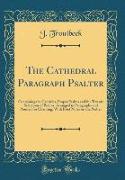- Start
- The Cathedral Paragraph Psalter
The Cathedral Paragraph Psalter
Angebote / Angebote:
Excerpt from The Cathedral Paragraph Psalter: Containing the Canticles, Proper Psalms and the Twenty Selections of Psalms, Arranged in Paragraphs and Pointed for Chanting, With Brief Notes on the PsalterAccepting the limitations imposed by the rigid structure of the Anglican Chant, and indeed by music itself as an art, advance must at present be looked for, in the Editor's opinion, along the line of careful, accurate, and graphic presentation, so far as IS attainable, of the meaning and teaching of the Psalms, not merely by seeking to improve any recognised system of pointing, as applied to single verses, but by such further and more important aids as the grouping of verses according to subject and feeling, the selection of appropriate Chants, Single, Double, Triple, Quadruple, the provision of Special Settings, and such like, regard being had to the construction and character of each Psalm or group of verses.As examples of Psalms for which Single Chants are suitable, may be mentioned Psalms 8, 15, 30, 67. Among the Psalms for which Double Chants are suitable, may be mentioned Psalms 3, 24, 38, 74. Triple Chants are suitable for Psalms 2, 39, 41, 76. 77, 96, 97, 137, 146, as well as for Psalms 1 and 98, when rearranged. As suitable for special treatment may be mentioned Psalms 18, 68, 78, 104, 105, 106, 107. Many, indeed most, of the Psalms can be equally well rendered musically by Single Chants as by Double. For the Gloria Patri, which is not to be looked upon as any part of the Psalm which it follows, either a Single or a Double Chant can be used.It will be found best to assign each Chant, whenever such an arrangement is practicable, to a whole Psalm, or a considerable section of a Psalm, in many instances comprising more than one subordinate group of verses, leaving it to the Organist and the Choir to give suitable expression to the several verses or subordinate groups within the Psalm or section, by means of renderings (which can be varied almost indefinitely, according to taste and musical skill), adapted to the changes and alternations of subject and feeling, which are often almost inextricably interwoven, and often succeed each other very rapidly.In view of the reliance which must naturally and necessarily be placed upon the taste and skill of the Organist, the Choirmaster, and the Choir itself, it has been thought sufficient to insert at the beginning of each group of verses, of whatever length, a mark (p, mf, f, 17) suggestive of the musical expression proper to it in general, without specifying more precisely, except when strong contrasts seem to call for it, the mode of dealing with each verse in the group. It is felt that while it is well to indicate general expression, to go too much into detail, even if it could be fully and satisfactorily carried out, might induce a fatiguing sense of restlessness, and tend to weaken, rather than enhance, the advantages of the system of grouping.About the PublisherForgotten Books publishes hundreds of thousands of rare and classic books. Find more at www.forgottenbooks.comThis book is a reproduction of an important historical work. Forgotten Books uses state-of-the-art technology to digitally reconstruct the work, preserving the original format whilst repairing imperfections present in the aged copy. In rare cases, an imperfection in the original, such as a blemish or missing page, may be replicated in our edition. We do, however, repair the vast majority of imperfections successfully, any imperfections that remain are intentionally left to preserve the state of such historical works.
Folgt in ca. 10 Arbeitstagen
